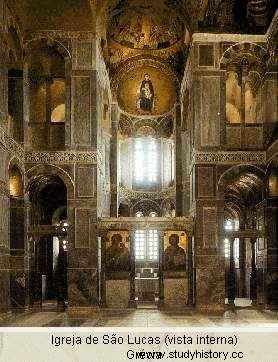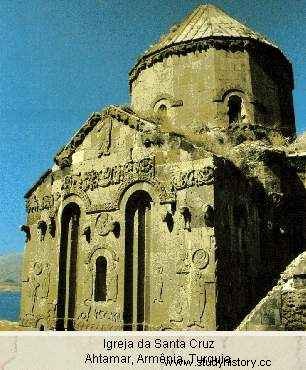Its capital was Constantinople (present-day Istanbul) which was converted into the capital of the Eastern Roman Empire in the year 330, after Constantine I the Great founded it in place of the old city of Byzantium, giving it its own name. It was the capital of the eastern Roman provinces, that is, of those areas of the Empire located in southeastern Europe, southwestern Asia and the northeastern part of Africa, which also included the present-day countries of the Balkan peninsula, western Turkey, Syria, Jordan, Israel, Lebanon, Cyprus, Egypt and the easternmost region of Libya. Its emperors considered the geographic limits of the Roman Empire as their own and looked to Rome for its traditions, symbols and institutions.

Emperor Justinian I and his wife, Theodora, tried to restore the ancient grandeur and geographic limits of the Roman Empire.
The Empire survived the migrations and incursions of the Goths and the Huns during the 5th and 6th centuries. In the 7th century, Emperor Heraclius I ended a major period of wars with the Persians, recovering Persian-occupied Syria, Palestine, and Egypt. Constantinople endured major sieges by the Arabs in the 670s and during the years 717 and 718.
At the beginning of the 9th century, the Byzantine Empire experienced a great recovery, reaching its fullness under the enduring reign of the Macedonian dynasty, which began with its founder, Emperor Basil I. Intellectual life revived. The cultural renaissance was accompanied by a conscious return to classical models in art and literature.
The greatest Macedonian emperor was Basil II, who vigorously suppressed a wide-ranging Bulgarian rebellion (1014) and extended his control to the independent principalities of Armenia and Georgia.
In 1071, the Seljuks invaded most of Byzantine Asia Minor. The Byzantines lost their last possessions in Italy and were separated from the Christian West due to the 1054 schism opened between the Orthodox Church and the Papacy.

Emperor Alexios I Komnenos, founder of the Komnenos dynasty, asked the Pope for help against the Turks. Western Europe responded with the first Crusade (1096-1099). Although, at first, the Empire benefited from the Crusades, recovering some territories in Asia Minor, these precipitated its decline.
Emperor Michael VIII Palaiologos, recovered Constantinople from the hands of the Latins in 1261 and founded the Palaiologos dynasty, which ruled until 1453. The Ottoman Turks, in full rise, conquered the rest of Byzantine Asia Minor in the early 14th century. After 1354, they occupied the Balkans and finally took Constantinople, which meant the end of the Empire in 1453.
However, the Byzantine intellectual tradition did not die in 1453:Byzantine scholars who visited Italy during the 14th and 15th centuries exerted a strong influence on the Italian Renaissance.
Roman Civilization
Take the opportunity to check out our video lesson on the subject:
